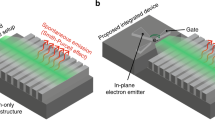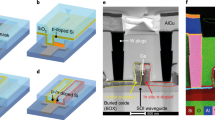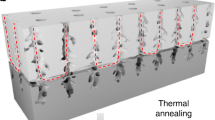Abstract
Silicon is the dominant semiconductor for electronics, but there is now a growing need to integrate such components with optoelectronics for telecommunications and computer interconnections1. Silicon-based optical modulators have recently been successfully demonstrated2,3; but because the light modulation mechanisms in silicon4 are relatively weak, long (for example, several millimetres) devices2 or sophisticated high-quality-factor resonators3 have been necessary. Thin quantum-well structures made from III-V semiconductors such as GaAs, InP and their alloys exhibit the much stronger quantum-confined Stark effect (QCSE) mechanism5, which allows modulator structures with only micrometres of optical path length6,7. Such III-V materials are unfortunately difficult to integrate with silicon electronic devices. Germanium is routinely integrated with silicon in electronics8, but previous silicon–germanium structures have also not shown strong modulation effects9,10,11,12,13. Here we report the discovery of the QCSE, at room temperature, in thin germanium quantum-well structures grown on silicon. The QCSE here has strengths comparable to that in III-V materials. Its clarity and strength are particularly surprising because germanium is an indirect gap semiconductor; such semiconductors often display much weaker optical effects than direct gap materials (such as the III-V materials typically used for optoelectronics). This discovery is very promising for small, high-speed14, low-power15,16,17 optical output devices fully compatible with silicon electronics manufacture.
This is a preview of subscription content, access via your institution
Access options
Subscribe to this journal
Receive 51 print issues and online access
$199.00 per year
only $3.90 per issue
Buy this article
- Purchase on Springer Link
- Instant access to full article PDF
Prices may be subject to local taxes which are calculated during checkout




Similar content being viewed by others
References
Miller, D. A. B. Rationale and challenges for optical interconnects to electronic chips. Proc. IEEE 88, 728–749 (2000)
Liu, A. et al. A high-speed silicon optical modulator based on a metal-oxide-semiconductor capacitor. Nature 427, 615–618 (2004)
Xu, Q., Schmidt, B., Pradhan, S. & Lipson, M. Micrometre-scale silicon electro-optic modulator. Nature 435, 325–327 (2005)
Soref, R. A. & Bennett, B. R. Electrooptical effects in silicon. IEEE J. Quant. Electron. 23, 123–129 (1987)
Miller, D. A. B. et al. Band-edge electroabsorption in quantum well structures: the quantum-confined Stark effect. Phys. Rev. Lett. 53, 2173–2176 (1984)
Arad, U. et al. Development of a large high-performance 2-D array of GaAs-AlGaAs multiple quantum-well modulators. IEEE Photon. Tech. Lett. 15, 1531–1533 (2003)
Liu, C. P. et al. Design, fabrication and characterisation of normal-incidence 1.56-µm multiple-quantum-well asymmetric Fabry-Perot modulators for passive picocells. IEICE Trans. Electron. E 86C, 1281–1289 (2003)
Cressler, J. D. SiGe HBT technology: a new contender for Si-Based RF and microwave circuit applications. IEEE Trans. Microwave Theory Tech. 46, 572–589 (1998)
Qasaimeh, O., Bhattacharya, P. & Croke, E. T. SiGe–Si quantum-well electroabsorption modulators. IEEE Photon. Tech. Lett. 10, 807–809 (1998)
Miyake, Y., Kim, J. Y., Shiraki, Y. & Fukatsu, S. Absence of Stark shift in strained Si1–xGex/Si type-I quantum wells. Appl. Phys. Lett. 68, 2097–2099 (1996)
Li, C. et al. Observation of quantum-confined Stark shifts in SiGe/Si type-I multiple quantum wells. J. Appl. Phys. 87, 8195–8197 (2000)
Park, J. S., Karunasiri, R. P. G. & Wang, K. L. Observation of large Stark shift in GexSi1–x/Si multiple quantum wells. J. Vac. Sci. Technol. B 8, 217–220 (1990)
Yakimov, A. I. et al. Stark effect in type-II Ge/Si quantum dots. Phys. Rev. B 67, 125318 (2003)
Lewen, R., Irmscher, S., Westergren, U., Thylen, L. & Eriksson, U. Segmented transmission-line electroabsorption modulators. J. Lightwave Technol. 22, 172–179 (2004)
Krishnamoorthy, A. V. & Miller, D. A. B. Scaling optoelectronic-VLSI circuits into the 21st century: a technology roadmap. IEEE J. Select. Top. Quant. Electron. 2, 55–76 (1996)
Kibar, O., Van Blerkom, D. A., Fan, C. & Esener, S. C. Power minimization and technology comparisons for digital free-space optoelectronic interconnections. J. Lightwave Technol. 17, 546–555 (1999)
Cho, H., Kapur, P. & Saraswat, K. C. Power comparison between high-speed electrical and optical interconnects for interchip communication. J. Lightwave Technol. 22, 2021–2033 (2004)
Miller, D. A. B. et al. Electric field dependence of optical absorption near the bandgap of quantum well structures. Phys. Rev. B 32, 1043–1060 (1985)
Helman, N. C., Roth, J. E., Bour, D. P., Altug, H. & Miller, D. A. B. Misalignment-tolerant surface-normal low-voltage modulator for optical interconnects. IEEE J. Select. Top. Quant. Electron. 11, 338–342 (2005)
Schmitt-Rink, S., Chemla, D. S., Knox, W. H. & Miller, D. A. B. How fast is excitonic electroabsorption? Opt. Lett. 15, 60–62 (1990)
Maslov, A. V. & Citrin, D. S. Quantum-well optical modulator at terahertz frequencies. J. Appl. Phys. 93, 10131–10133 (2003)
Galdin, S., Dollfus, P., Aubry-Fortuna, V., Hesto, P. & Osten, H. J. Band offset predictions for strained group IV alloys: Si1-x-yGexCy on Si(001) and Si1-xGex on Si1-zGez(001). Semicond. Sci. Technol. 15, 565–572 (2000)
Rieger, M. M. & Vogl, P. Electronic-band parameters in strained Si1-xGex alloys on Si1-yGey substrates. Phys. Rev. B 48, 14276–14287 (1993)
Schaffler, F. High-mobility Si and Ge structures. Semicond. Sci. Technol. 12, 1515–1549 (1997)
Goossen, K. W., Yan, R. H., Cunningham, J. E. & Jan, W. Y. AlxGa1-xAs-AlAs quantum well surface-normal electroabsorption modulators operating at visible wavelengths. Appl. Phys. Lett. 59, 1829–1831 (1991)
Crow, G. C. & Abram, R. A. Monte Carlo simulations of hole transport in SiGe and Ge quantum wells. Semicond. Sci. Technol. 15, 7–14 (2000)
Dresselhaus, G., Kip, A. F. & Kittel, C. Cyclotron resonance of electrons and holes in silicon and germanium crystals. Phys. Rev. 98, 368–384 (1955)
Lawaetz, P. Valence-band parameters in cubic semiconductors. Phys. Rev. B 4, 3460–3467 (1971)
Acknowledgements
We thank V. Lordi for help with photocurrent setup. We also thank J. Fu, T. Krishnamohan and X. Yu for help with device fabrication and material characterization. Finally, we thank G. S. Solomon and D. S. Gardner for discussions. This work was supported by Intel Corporation and the DARPA/ARO EPIC programme.
Author information
Authors and Affiliations
Corresponding author
Ethics declarations
Competing interests
Reprints and permissions information is available at npg.nature.com/reprintsandpermissions. The authors declare no competing financial interests.
Rights and permissions
About this article
Cite this article
Kuo, YH., Lee, Y., Ge, Y. et al. Strong quantum-confined Stark effect in germanium quantum-well structures on silicon. Nature 437, 1334–1336 (2005). https://doi.org/10.1038/nature04204
Received:
Accepted:
Issue Date:
DOI: https://doi.org/10.1038/nature04204
This article is cited by
-
Breaking the symmetry of colloidal 2D nanoplatelets: Twist induced quantum coupling
Nano Research (2023)
-
Optical detection of charge accumulation in an electrically anisotropic semimetal of WTe2
Journal of the Korean Physical Society (2022)
-
Electro-absorption modulation in GeSn alloys for wide-spectrum mid-infrared applications
Communications Materials (2021)
-
Quantum tunneling in two-dimensional van der Waals heterostructures and devices
Science China Materials (2021)
-
Dynamic beam steering with all-dielectric electro-optic III–V multiple-quantum-well metasurfaces
Nature Communications (2019)
Comments
By submitting a comment you agree to abide by our Terms and Community Guidelines. If you find something abusive or that does not comply with our terms or guidelines please flag it as inappropriate.



